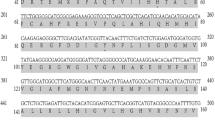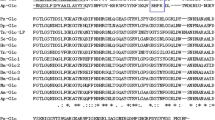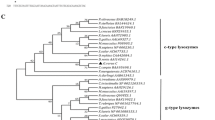Abstract
Peptidoglycan recognition protein II (pglyrp2) is a type of pattern recognition receptor (PRR) that has amidase activity and is structurally conserved through evolution. However, their contributions in immune defense are different between mammal pglyrp2 and its counterpart in insects. Hitherto, fish pglyrp2 was poorly known in its structure, expression pattern and its contribution in immune defense. In present study, the pglyrp2 gene of the large yellow croaker (Pseudosciaena crocea) was cloned by RACE approach; the full-length cDNA (1842 bp) of pglyrp2 of P. crocea contains a 1446 bp open reading frame that encodes a putative protein of 482 amino acids (aa) with one 21-residue signal peptide. The pglyrp2 fusion protein and mature peptide fusion protein of P. crocea expressed by pET28a vector in the insoluble inclusion bodies (IBs) of Escherichia coli BL21 were confirmed by SDS-PAGE and subsequently purified to homogeneity by Ni-NTA agarose affinity chromatography. In addition, quantitative Real-time PCR (QRT-PCR) assays indicated that large yellow croaker pglyrp2 could be strongly expressed in liver and weakly in gonad, intestine, and stomach. Also, maternally derived pglyrp2 mRNA displayed a high level in unfertilized eggs and low expression throughout embryogenesis and yolk-sac larvae stage. Moreover, as shown in an artificial infection model, the pglyrp2 of P. crocea was confirmed to be a constitutive and inducible acute-phase protein, inducibility of which correlated with activation of anti-oxidant defense response. Thus, pglyrp2 of P. crocea was believed to play an important role in defending the eggs, bacteria recognition and activation of downstream host immune defense.








Similar content being viewed by others
References
Medzhitov R, Janeway CAJ (2002) Decoding the patterns of self and nonself by the innate immune system. Science 296:298–300. doi:10.1126/science.1068883
Hoffmann JA (2003) The immune response of Drosophila. Nature 426:33–38. doi:10.1038/nature02021
Kang D, Liu G, Lundstrom A et al (1998) A peptidoglycan recognition protein in innate immunity conserved from insects to humans. Proc Natl Acad Sci USA 95:10078–10082. doi:10.1073/pnas.95.17.10078
Dziarski R (2004) Peptidoglycan recognition proteins (PGRPs). Mol Immunol 40:877–886. doi:10.1016/j.molimm.2003.10.011
Leulier F, Parquet C, Pili-Floury S et al (2003) The Drosophila immune system detects bacteria through specific peptidoglycan recognition. Nat Immunol 4:478–484. doi:10.1038/ni922
Michel T, Reichhart JM, Hoffmann JA et al (2001) J. Drosophila toll is activated by Gram-positive bacteria through a circulating peptidoglycan recognition protein. Nature 414:756–759. doi:10.1038/414756a
Xu M, Wang Z, Locksley RM (2004) Innate immune responses in peptidoglycan recognition protein L-deficient mice. Mol Cell Biol 24:7949–7957. doi:10.1128/MCB.24.18.7949-7957.2004
Wang H, Gupta D, Li X et al (2005) Peptidoglycan recognition protein 2 (N-acetylmuramoyl-L-Ala amidase) is induced in keratinocytes by bacteria through the p38 kinase pathway. Infect Immun 73:7216–7225. doi:10.1128/IAI.73.11.7216-7225.2005
Zhang Y, Vander FL, Voerman JS et al (2005) Identification of serum N-acetylmuramoyl-L-alanine amidase as liver peptidoglycan recognition protein 2. Biochim Biophys Acta 1752:34–46
Wang ZM, Li X, Cocklin RR et al (2003) Human peptidoglycan recognition protein-L is an N-acetylmuramoyl-L-alanine amidase. J Biol Chem 278:49044–49052. doi:10.1074/jbc.M307758200
Li X, Wang S, Qi J et al (2007) Zebrafish peptidoglycan recognition proteins are bactericidal amidases essential for defense against bacterial infections. Immunity 27:518–529. doi:10.1016/j.immuni.2007.07.020
Austin B, Zhang XH (2006) Vibrio harveyi: a significant pathogen of marine vertebrates and invertebrates. Lett Appl Microbiol 43:119–124. doi:10.1111/j.1472-765X.2006.01989.x
Oh MJ, Kim WS, Kitamura SI et al (2006) Change of pathogenicity in Olive flounder Paralichthys olivaceus by co-infection of Vibrio harveyi, Edwardsiella tarda and marine birnavirus. Aquaculture 257:156–160. doi:10.1016/j.aquaculture.2006.03.009
Zhang C, Yu L, Qian R (2008) Cloning and expression of Vibrio harveyi OmpK* and GAPDH* genes and their potential application as vaccines in large yellow croakers Pseudosciaena crocea. J Aquat Anim Health 20(1):1–11. doi:10.1577/H06-031.1
Chen YF, Wang J, Su YQ et al (2006) Study on the extra cellular products (ECP) of the pathogenic Vibrio harveyi isolated from the farmed groupers. Mark Sci 30(10):30–34 in Chinese
Laemmli UK (1970) Cleavage of structural proteins during the assembly of the head of bacteriophage T4. Nature 227:680–685. doi:10.1038/227680a0
Chang MX, Nie P, Wei LL (2007) Short and long peptidoglycan recognition proteins (PGRPs) in zebrafish, with findings of multiple PGRP homologs in teleost fish. Mol Immunol 44:3005–3023. doi:10.1016/j.molimm.2006.12.029
Pérez-Fuentes R, Torres-Rasgado E, Salgado-Rosas H et al (2008) The anti-oxidant defence response in individuals with the indeterminate form of Chagas disease (American trypanosomiasis). Ann Trop Med Parasitol 102:189–197. doi:10.1179/136485908X267858
Guzik TJ, Olszanecki R, Sadowski J et al (2005) Superoxide dismutase activity and expression in human venous and arterial bypass graft vessels. J Physiol Pharmacol 56:313–323
Chaves-Pozo E, Muñoz P, López-Muñoz A et al (2005) Early innate immune response and redistribution of inflammatory cells in the bony fish gilthead seabream experimentally infected with Vibrio anguillarum. Cell Tissue Res 320:61–68. doi:10.1007/s00441-004-1063-7
Werner T, Liu G, Kang D (2000) A family of peptidoglycan recognition proteins in the fruit fly Drosophila melanogaster. Proc Natl Acad Sci USA 97:13772–13777. doi:10.1073/pnas.97.25.13772
Liu C, Xu Z, Gupta D et al (2001) Peptidoglycan recognition proteins: a novel family of four human innate immunity pattern recognition molecules. J Biol Chem 276:34686–34694. doi:10.1074/jbc.M105566200
Kibardin AV, Mirkina II, Baranova EV et al (2003) The differentially spliced mouse tagL gene, homolog of tag7/PGRP gene family in mammals and Drosophila, can recognize Gram-positive and Gram-negative bacterial cell wall independently of T phage lysozyme homology domain. J Mol Biol 326:467–474. doi:10.1016/S0022-2836(02)01401-8
Sang Y, Ramanathan B, Ross CR et al (2005) Gene silencing and overexpression of porcine peptidoglycan recognition protein long isoforms: involvement in beta-defensin-1 expression. Infect Immun 73:7133–7141. doi:10.1128/IAI.73.11.7133-7141.2005
Lu X, Wang M, Qi J et al (2006) Peptidoglycan recognition proteins are a new class of human bactericidal proteins. J Biol Chem 281:5895–5907. doi:10.1074/jbc.M511631200
Huttenhuis HB, Grou CP, Taverne-Thiele AJ et al (2006) Carp (Cyprinus carpio L.) innate immune factors are present before hatching. Fish Shellfish Immunol 20:586–596. doi:10.1016/j.fsi.2005.07.008
Guan R, Mariuzza RA (2007) Peptidoglycan recognition proteins of the innate immune system. Trends Microbiol 15:127–134. doi:10.1016/j.tim.2007.01.006
Ochiai M, Ashida M (1999) A pattern recognition protein for peptidoglycan: cloning of the cDNA and the gene of the silkworm, Bombyx mori. J Biol Chem 274:11854–11858. doi:10.1074/jbc.274.17.11854
Dimopoulos G, Christophides GK, Meister S et al (2002) Genome expression analysis of Anopheles gambiae: responses to injury, bacterial challenge, and malaria infection. Proc Natl Acad Sci USA 99:8814–8819. doi:10.1073/pnas.092274999
Christophides GK, Zdobnov E, Barillas-Mury C et al (2002) Immunity related genes and gene families in Anopheles gambiae. Science 298:159–165. doi:10.1126/science.1077136
Li X, Wang S, Wang H et al (2006) Differential expression of peptidoglycan recognition protein 2 in the skin and liver requires different transcription factors. J Biol Chem 281:20738–20744. doi:10.1074/jbc.M601017200
Ni D, Song L, Wu L et al (2007) Molecular cloning and mRNA expression of peptidoglycan recognition protein (PGRP) gene in bay scallop (Argopecten irradians, Lamarck 1819). Dev Comp Immunol 31:548–558. doi:10.1016/j.dci.2006.09.001
Acknowledgments
This work is supported by a grant from 863 High Technology Project (No. 2006AA10A405) from the Chinese Ministry of Science and Technology.
Author information
Authors and Affiliations
Corresponding author
Rights and permissions
About this article
Cite this article
Mao, Y., Wang, J., Zhang, Z. et al. Cloning, mRNA expression, and recombinant expression of peptidoglycan recognition protein II gene from large yellow croaker (Pseudosciaena crocea). Mol Biol Rep 37, 3897–3908 (2010). https://doi.org/10.1007/s11033-010-0046-x
Received:
Accepted:
Published:
Issue Date:
DOI: https://doi.org/10.1007/s11033-010-0046-x




